Jonah Bokaer and Daniel Arsham bring their latest work to BAM Howard Gilman Opera House.
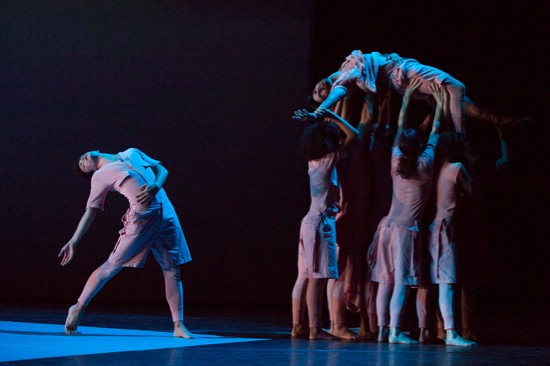
Rules of the Game by Jonah Bokaer and Daniel Arsham. At left: Szabo Pataki. Lifted: James Koroni. Photo: Yi-Chun Wu
Hooded figures swathed in pale clothing stand, isolated in pools of light, on the stage of the BAM Gilman Opera House, as part of BAM’s Next Wave Festival. Their faces are hidden, and they’re frozen in diverse positions. In place when we enter the theater, they could be statues awaiting renovation. This is the way Jonah Bokaer introduces “The Rules of the Game,” a program by himself and visual artist Daniel Arsham: (those words also form the title of the evening’s most recent work). Another figure, wearing darker clothing stands at the shadowy back of the stage, unidentifiable until an upside down funnel of light reveals it to be Bokaer. The others come to life and cede the stage to him.
The first two works on the program—Recess (2010) and Why Patterns (2011)—pit human efforts and skills against objects that either have wills of their own or have been magicked by some outside, not necessarily malevolent force. Were they not so pristine, you might think of these dances as depicting strange cultures, like those that Dorothy Gale and her comrades encounter as they travel the Land of Oz: “The Hungry Paper Mountains,” say, and “The Ping-Pongers.” In the first, Bokaer carefully and thoughtfully dances on an immense sheet of white paper, angling himself in relation to it. By the time he has finished, he has folded and ripped and gathered it into mountains that appear to want to engulf him (James McGinn operates invisibly under the paper).
In Why Patterns, four people (Laura Gutierrez, McGinn, Szabo Pataki, and either Sara Procopio or Callie Lyons, depending on the night that one attended the performance) are bombarded by ping-pong balls; these incursions are scanty at first, but develop into floods—from overhead, from high in a stage-right wing. Part of the quartet’s job is herding the balls into piles; however, the slim clear plastic tubes that fence in their floor space contain ping-pong balls themselves. Lift one, tilt it, and you’ve created a new tributary of round white objects. (I wrote about these two works in more depth, but with a different cast, when they were performed at Jacob’s Pillow: https://www.artsjournal.com/dancebeat/2011/08/what-shape-are-you-in/).
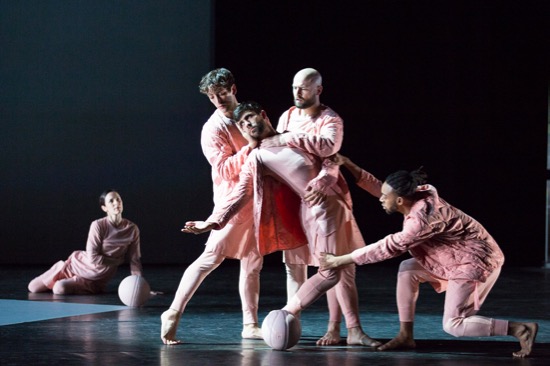
Jonah Bokaer and Daniel Arsham’s Rules of the Game. Held: James Koroni. (L to R): Sara Procopio, James McGinn, Szabo Pataki, and Wendell Gray II. Photo: Yi-Chun Wu
Rules of the Game premiered last May at Dallas’s Winspear Opera House as the opening event of the city’s Soluna Festival. Judging by the attendant publicity, the big draw was not Bokaer’s choreography or Arsham’s scenography, but the music by Pharrell Williams (on old buddy of Arsham’s), which had been arranged for orchestra by David Campbell. Campebell conducted the Dallas Symphony Orchestra at Rules of the Game’s Texas debut (the BAM audience heard it recorded).
The layers in this remarkable piece are many. Its title is that of a 1918 play by Luigi Pirandello to do with extra-marital shenanigans and underhanded actions that lead to a tragic duel. However, the collaborators were inspired by a slightly later Pirandello work, Six Characters in Search of an Author. A play within a play, it depicts a group of actors, their director, and stage manager, et al, who are already rehearsing one play, when six mysterious “characters” arrive and ask that the actors instead put on the tragic story of incest and death that they have lived through. The troupe agrees to try it. The strategies of life and art vie, as do experience and the simulation of it.
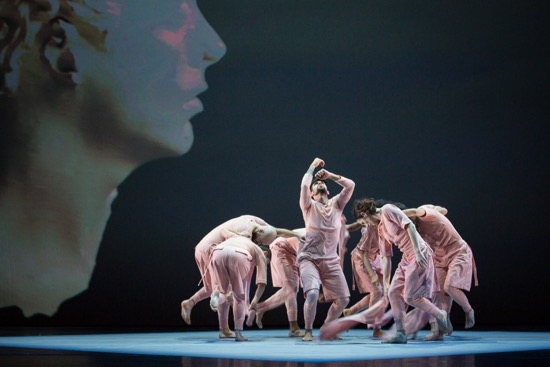
Daniel Arsham’s scenic design and Jonah Bokaer’s choreography. Center: Szabi Pataki. Photo: Yi-Chun Wu
Bokaer and his colleagues, however, are not enacting this plot, although elements of narrative suddenly cohere and, just as suddenly, fall apart. Arsham has created a work of video art that resonates with this atmosphere. The first images we see are of immense Spalding basketballs rolling in limbo; they have big chunks taken out of them, so that their damaged innards show. Smaller balls later appear on stage, to roll or be thrown in a brief, stoic game. The balls on video are replaced by images of gigantic Greco-Roman-style terracotta (?) heads that swim across the screen, slide down it, or float up it. So does the occasional arm, or a hand with most of its fingers missing. The sculptures look broken off at the neck, their surfaces mottled and ruined. Occasionally, they shatter, the clay fragments flying around; but they also reassemble themselves—a cracked cheek closing the gap between it and the part bearing the nose. Late in the dance, the performers make an entrance carrying three-dimensional models of the heads, displaying them, protecting them.
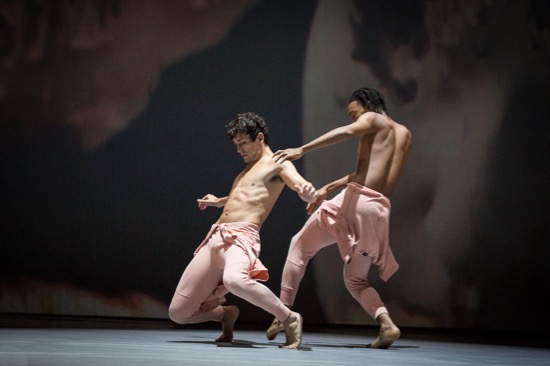
James McGinn (L) and Wendell Gray II fight in Rules of the Game. Photo: Yi-Chun Wu
Like both Pirandello’s plot and archeological digs, the ingenious costumes by Chris Stamp/STAMPD are layered. Dusty pink, they can turn cerise in Aaron Copp’s lighting. At first, the dancers wear hoods (or maybe caps over hoods) and coats. As Rules of the Game proceeds, they will shuck these, plus jackets, vests, blouses, and shorts, to end up in handsome long johns. When first removed, the jackets become part of the dance pattern, to be flourished in the air and smacked against the floor. You might begin to expect that the performers’d be naked by the end of the dance, but only part of the last layer is removed when Wendell Gray II and McGinn shrug out of the top halves of their union suits and leave them dangling, as they engage in slow, brutal combat that ends with one man strangling the other.
The music develops strong beats, but it also sings. We hear sweet melodies like those that may accompany a movie love scene or rougher sounds to emphasize struggles or more delicate suspended tinkling. I think I also heard male voices at one point and those of children. The dancing is full out, but looser and occasionally more violent than that in previous works by Bokaer that I’ve seen. A performer may crawl laboriously or flinch or recoil. Yet fights end without victory and defeat emphasized; the antagonists move on. They also assist one another. They embrace. Several times, Lyons falls backward and is caught by Pataki or Gray. They form tableaux: a cluster assembles at various levels around Pataki, who stands atop Koroni; think of a statuary group featuring a heroic ship’s captain. They join together in squads or lines.
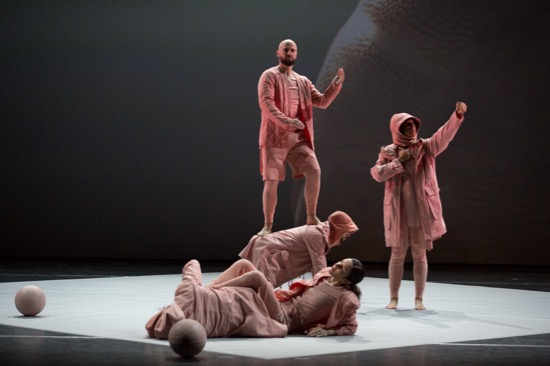
Szabo Pataki standing on James Koroni (L to R): unidentified, Sara Procopio, and Callie Lyons. Photo: Yi-Chun Wu
The dancers are marvelous—inside every action, understanding it, inhabiting it. Those not previously mentioned in connection with Rules of the Game (Gutierrez, James Koroni, Betti Roller, and Procopio) are no less important than those named.
Bokaer, a computer expert, has written a program note that I, a non-expert, am slow to understand; it centers on the term “tag,” which he uses to identify how “deeply creative minds” (meaning Williams, Arsham, and Campbell) have been tagged into “the very fluid medium of choreography.” He also uses the word in a game sense: get tagged and you’re it. And in a financial sense: art like this comes with a price tag. But tagging can involve passing something on to rivals or teammates, as these collaborators have done. Or stirring up ideas and connections in the spectators. Consider me tagged.
